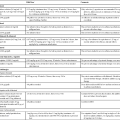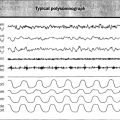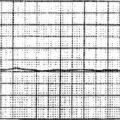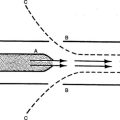Assisted Ventilation for Pediatric Patients
I General Concepts of Ventilation (Box 30-1)
A Alveolar ventilation: The measure of the adequacy of ventilation; CO2 removal is directly related to alveolar ventilation.
B Compliance: The measure of distensibility of the lungs and thorax expressed as the volume change in the lung per unit of pressure change. The higher the compliance, the greater the volume change in the lungs for a given change in pressure. With a reduction in compliance, a greater pressure gradient is required to move a given volume of gas into the lungs.
C Resistance: The measure of the tendency for the airways and lung tissue to resist the flow of gas expressed as the change in pressure per unit of gas flow: the greater the resistance to gas flow, the greater the pressure gradient necessary to deliver a volume of gas in a given time interval.
D Time constant: The relationship between compliance and resistance and pressure equilibration between patient and ventilator circuit, or filling and emptying of the lungs during inspiration and expiration. One time constant is the measure of the time necessary for alveolar pressure to equilibrate to 63% of a change in airway pressure; 99% pressure equilibration occurs in lungs with normal compliance and resistance in approximately five time constants.
II Continuous Positive Airway Pressure (CPAP)
1. Continuous distending pressure maintained throughout respiratory cycle.
2. Prevents alveolar collapse during expiration, and reduces the pressure required to open alveoli during inspiration.
3. Improves and maintains functional residual capacity (FRC) and ventilation-perfusion relationship.
1. The variable that a ventilator controls to effect inspiration
3. Mandatory and spontaneous ventilator-supported breaths are classified as pressure controlled or volume controlled.
B Pressure-control ventilation (PCV)
1. Pressure is the variable that the ventilator controls to effect inspiration.
2. The shape of the inspiratory pressure waveform remains consistent breath to breath as compliance and resistance change.
3. Flow pattern and delivered tidal volume (Vt) vary depending on changes in compliance and resistance.
4. Volume delivery primarily depends on the change in pressure from baseline to peak pressure, referred to as delta-P (ΔP).
5. As the lungs fill and lung pressure approaches the set pressure target or limit (circuit pressure), the inspiratory gas flow rate to the patient decreases or decelerates.
6. Time-cycled, pressure-limited (TCPL)
a. Most common type of ventilation used to support infants weighing <10 kg
b. Pressure-controlled, incorporating a continuous flow of gas through the breathing circuit, a pneumatic exhalation valve, and a timing mechanism
c. The breath rate setting determines a fixed time interval to trigger mandatory breaths.
d. During inspiration the exhalation valve closes; flow is diverted to the inspiratory limb; pressure builds to a preset limit; and the breath is cycled after a preset inspiratory interval.
C Pressure support ventilation (PSV)
1. PSV is used to support spontaneous breaths.
2. Triggered by patient inspiratory effort, the ventilator provides the inspiratory flow necessary to reach and maintain a set pressure support level (pressure limit) for the duration of inspiratory time.
3. Breaths are terminated (cycled) when inspiratory flow decreases to a predetermined level, usually a percentage of peak inspiratory flow rate.
4. The change in inspiratory flow rate depends on patient demand and lung mechanics.
D Volume-control ventilation (VCV)
1. Volume and flow, which are functions of each other, are the control variable.
2. A set Vt is delivered in an inspiratory time that is either directly set or set indirectly as the result of setting a peak inspiratory flow rate.
3. Volume is constant from breath to breath, and the pressure gradient required to deliver a given volume varies with changes in compliance and resistance.
1. All breaths are mandatory and are time triggered by the ventilator at an interval determined by the breath rate setting or patient triggered if the patient’s inspiratory effort meets the set-triggering criteria.
2. All delivered breaths can be either volume controlled (e.g., AC-VCV) or pressure controlled (e.g., AC-PCV).
V Indications for Mechanical Ventilation (Box 30-2)
VI Pediatric Ventilator Settings
1. The disease process and the size of the child are considered when selecting ventilator settings.
2. Manual ventilation is useful to assess the compliance of the lungs while observing the chest excursion and evaluating breath sounds.
3. Peak inspiratory pressure (PIP) and positive end-expiratory pressure (PEEP) observed on an airway manometer during manual ventilation are noted and used as a guide to select the initial ventilator settings.
1. SIMV volume or pressure controlled
a. Allows the patient to perform some of the ventilator work with the guarantee that an adequate minute volume (VE) may enhance patient-ventilator synchrony.
b. VCV-SIMV is typically used as the initial mode to ventilate older pediatric patients.
c. One disadvantage of VCV is the potential for excessive airway pressures that can lead to barotrauma/volutrauma, hemodynamic compromise, and patient-ventilator dysynchrony.
d. PCV-SIMV is used when high inflation pressures are observed, such as in patients with decreased lung compliance and/or increased airflow obstruction in which PIP >35 cm H2O is required during VCV.
1. Adjusted in VCV and measured in PCV
2. Consider patient size and underlying condition
3. Effective Vt of 7 to 10 ml/kg is considered a good starting point.
4. Vt >10 ml/kg may be potentially deleterious.
5. Larger Vt may require the use of higher PIP, which may increase compressible volume loss and lower effective Vt delivery; the set Vt may not reflect the true or effective Vt.
b. PIP is generally comparable with the plateau pressure (Pplat) measured during VCV and used as a starting point.
c. If Pplat is not available, the initial PIP should be set 2 to 5 cm H2O lower than the PIP that was measured during VCV.
d. Because PIP is constant, the risks of barotrauma are somewhat minimized; however, if delivered Vt or PIP is excessive, volutrauma may occur.
1. Generally set at 10 to 25 breaths/min
2. Frequencies >30 breaths/min are rarely used in children because of the potential for gas trapping.
3. Patients with obstructive lung disease (e.g., asthma) will benefit from slower ventilator rates that allow more time for expiration.
4. Patients with elevated intracranial pressures are treated with hyperventilation and ventilated with faster rates.
1. Ti is adjusted to establish the inspiration/expiration (I:E) ratio.
2. Ti affects patient comfort and patient/ventilator synchrony. When selecting a Ti, patient age, breathing pattern, and disease process are considered.
3. General range is approximately 0.5 second for small children to approximately 1.0 second for large children.
4. Set directly or indirectly by adjusting inspiratory flow rate.
5. As Ti is lengthened in VCV, flow is decreased, and a more laminar flow pattern is created, decreasing PIP.
6. An I:E ratio of 1:2 or 1:3 is commonly set.
7. Prolonged Ti can be used to increase mean airway pressure (Paw) and improve oxygenation in those with acute respiratory failure, provided that the time for expiration is sufficient to avoid stacking of breaths and associated complications.
8. In the lung recovery phase and in the patient who is spontaneously breathing, a long Ti may result in patient/ventilator dysynchrony because the patient may begin to exhale before the mandatory breath cycles to exhalation.
9. Shortened Ti should be used when severe airflow obstruction is present, thus providing a longer expiratory phase.
1. VCV inspiratory flow rate is either set directly or indirectly as a result of setting inspiratory time.
2. Adequate inspiratory flow meets patient demand, whereas insufficient inspiratory flow may lead to increased work of breathing if spontaneous inspiratory flow demand is greater than the inspiratory flow rate provided.
3. PCV inspiratory flow is variable depending on PIP, lung mechanics, and patient demand.
1. Provides alveolar recruitment and varies depending on the severity of lung disease
2. Generally started at 3 to 5 cm H2O
3. Increases are made in increments of 2 cm H2O in patients with conditions with low lung compliance (e.g., acute respiratory distress syndrome) to improve lung recruitment and oxygenation.
4. Optimal PEEP is considered the level that achieves the best lung compliance and oxygenation with the fewest cardiovascular side effects.
5. PEEP >15 cm H2O should be avoided because of the risk of cardiovascular compromise.
6. Lung hyperinflation leading to decreased compliance, increased pulmonary vascular resistance, increased deadspace, and decreased oxygen delivery may result from excessive PEEP.
7. PEEP is applied judiciously in patients with airflow obstruction (e.g., asthma) because lung hyperinflation may be exacerbated.
1. FIO2 is set to the lowest concentration that provides acceptable arterial oxygenation.
2. By increasing PEEP or other ventilator manipulations to reduce the FIO2 to <0.60 in those with severe lung disease, Paw is typically increased.
3. Additional strategies to minimize adverse effects of high FIO2 include accepting Pao2 of 50 to 70 mm Hg or Spo2 >85%, provided that hemoglobin levels are adequate, cardiovascular status is stable, and metabolic acidosis does not develop secondary to tissue hypoxia.
1. Permissive hypercapnia (allowing Pco2 to increase >45 cm H2O) is achieved by limitation of ventilator support (Paw and Vt) to avoid lung overdistention.
2. Used to prevent or reduce the severity of ventilator-induced lung injury
3. Peak alveolar pressures (end-inspiratory Pplat) should be maintained <30 cm H2O.
4. PEEP is applied as needed to maintain adequate lung volume.
6. If necessary Paco2 is allowed to gradually increase above the normal clinical range to ≥50-100 mm Hg, provided that pH is maintained >7.25 with metabolic compensation.
VII Monitoring Mechanical Ventilation in the Pediatric Patient
1. Clinically acceptable blood gas parameters are established depending on the disease state and level of acuity.
2. Used as a guide to select and modify ventilator settings.
3. Permissive hypercapnia (Paco2, 50 to 100 mm Hg; pH, ≥7.25) is considered when the risk of ventilator-induced lung injury is high.
4. Arterial oxygen tensions of 50 to 70 mm Hg are frequently tolerated and permit the use of lower, less toxic, oxygen concentrations, provided that metabolic acidosis from tissue hypoxia does not occur.
B Noninvasive measures of gas exchange
1. Changes in vital signs alert clinicians of physiologic responses to changes in ventilator settings.
D Patient-ventilator interaction
1. Airway pressure measurements, including PIP, Paw, and Pplat
a. Increased PIP in VCV is commonly attributed to decreased lung compliance, increased airway resistance, patient-ventilator dysynchrony, or airway secretions.
b. Paw>15 indicates worsening lung disease and is associated with barotrauma.
c. Because increasing Paw is required to maintain adequate oxygenation, alternative ventilator management strategies, such as permissive hypercapnia or high frequency ventilation, should be considered.
d. Pplat (an indication of peak alveolar pressure) is used to calculate static compliance, which can be trended when adjusting ventilator settings.
e. Auto-PEEP should be monitored if there is a suspicion of air trapping.
VIII Weaning the Pediatric Patient from Mechanical Ventilation
1. Stable cardiovascular system with minimal or no vasopressor support
2. Acceptable respiratory mechanics
4. Adequate spontaneous Vt (e.g., 3 to 5 ml/kg)
6. Maximum inspiratory pressure can be obtained in older children as a gauge of muscle effort and should be at least −20 cm H2O.
7. Forced vital capacity (FVC) may also be obtained and should be 10 ml/kg.
8. Improved chest radiographic findings
1. PSV assists spontaneous respiratory efforts.
2. Decreases the work of breathing imposed by artificial airways, ventilator circuits, and demand systems
3. Improves patient/ventilator synchrony
4. May prevent respiratory muscle fatigue
5. Titrated to maintain a Vt of 5 to 7 ml/kg
6. Decreased in increments of 1 to 2 cm H2O while observing delivered Vt
7. Slowly returns work of breathing to patient
8. Used in conjunction with extubation readiness evaluation (Box 30-4)
1. Alveolar rupture and the dissection of air into various thoracic compartments
C Airway complications associated with ETT
X High Frequency Oscillatory Ventilation
1. Recruit and maintain lung volume above alveolar closing volume
2. Improve gas exchange without allowing lungs to open and close with each breath (Box 30-5).







